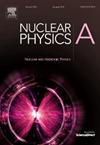LUNA的17O(p,γ)18F反应中65 keV共振强度的首次直接测量
IF 2.5
4区 物理与天体物理
Q2 PHYSICS, NUCLEAR
引用次数: 0
摘要
在氢燃烧活跃的恒星环境中,要预测氧同位素的丰度比,必须精确测定氧的质子俘获率。特别是17O(p,γ)18F反应,在AGB核合成以及新星和I型超新星中发生的爆炸性氢燃烧中起着至关重要的作用。在前一种情况下(20 MK≤T≤80 MK),天体物理反应速率的主要贡献来自Er = 64.5 keV共振。这种共振的强度目前只能通过间接测量来确定,采用的值ωγ =(1.6±0.3)× 10−11 eV。位于Gran Sasso国家实验室的LUNA上安装了一个新的高灵敏度装置。月球400kV的地下位置保证了宇宙射线背景的几个数量级的减少。专门的屏蔽进一步减少了残余背景。另一方面,采用铝制靶室和支架优化了4π-BGO探测器的效率。在Ta2O5目标上积累了大约400℃,标称富集了90%的17O, LUNA合作首次直接测量了64.5 keV的共振强度。本文章由计算机程序翻译,如有差异,请以英文原文为准。
The challenging first direct measurement of the 65 keV resonance strength in the 17O(p,γ)18F reaction at LUNA
A precise determination of the proton capture rates on oxygen is mandatory to predict the abundance ratios of oxygen isotopes in a stellar environment where the hydrogen burning is active. The 17O(p,γ)18F reaction, in particular, plays a crucial role in AGB nucleosynthesis as well as in explosive hydrogen burning occurring in novae and type I supernovae. At the temperature of interest for the former scenario (20 MK ≤ T ≤ 80 MK) the main contribution to the astrophysical reaction rate comes from the = 64.5 keV resonance. The strength of this resonance is presently determined only through indirect measurements, with an adopted value ωγ = (1.6 ± 0.3) × 10−11 eV. A new high sensitivity setup has been installed at LUNA, located at Laboratori Nazionali del Gran Sasso. The underground location of LUNA 400kV guarantees a reduction of the cosmic ray background by several orders of magnitude. The residual background was further reduced by a dedicated shielding. On the other hand the 4π-BGO detector efficiency was optimized installing an aluminum target chamber and holder. With about 400 C accumulated on Ta2O5 targets, with nominal 17O enrichment of 90%, the LUNA collaboration has performed the first ever direct measurement of the 64.5 keV resonance strength.
求助全文
通过发布文献求助,成功后即可免费获取论文全文。
去求助
来源期刊

Nuclear Physics A
物理-物理:核物理
CiteScore
3.60
自引率
7.10%
发文量
113
审稿时长
61 days
期刊介绍:
Nuclear Physics A focuses on the domain of nuclear and hadronic physics and includes the following subsections: Nuclear Structure and Dynamics; Intermediate and High Energy Heavy Ion Physics; Hadronic Physics; Electromagnetic and Weak Interactions; Nuclear Astrophysics. The emphasis is on original research papers. A number of carefully selected and reviewed conference proceedings are published as an integral part of the journal.
 求助内容:
求助内容: 应助结果提醒方式:
应助结果提醒方式:


